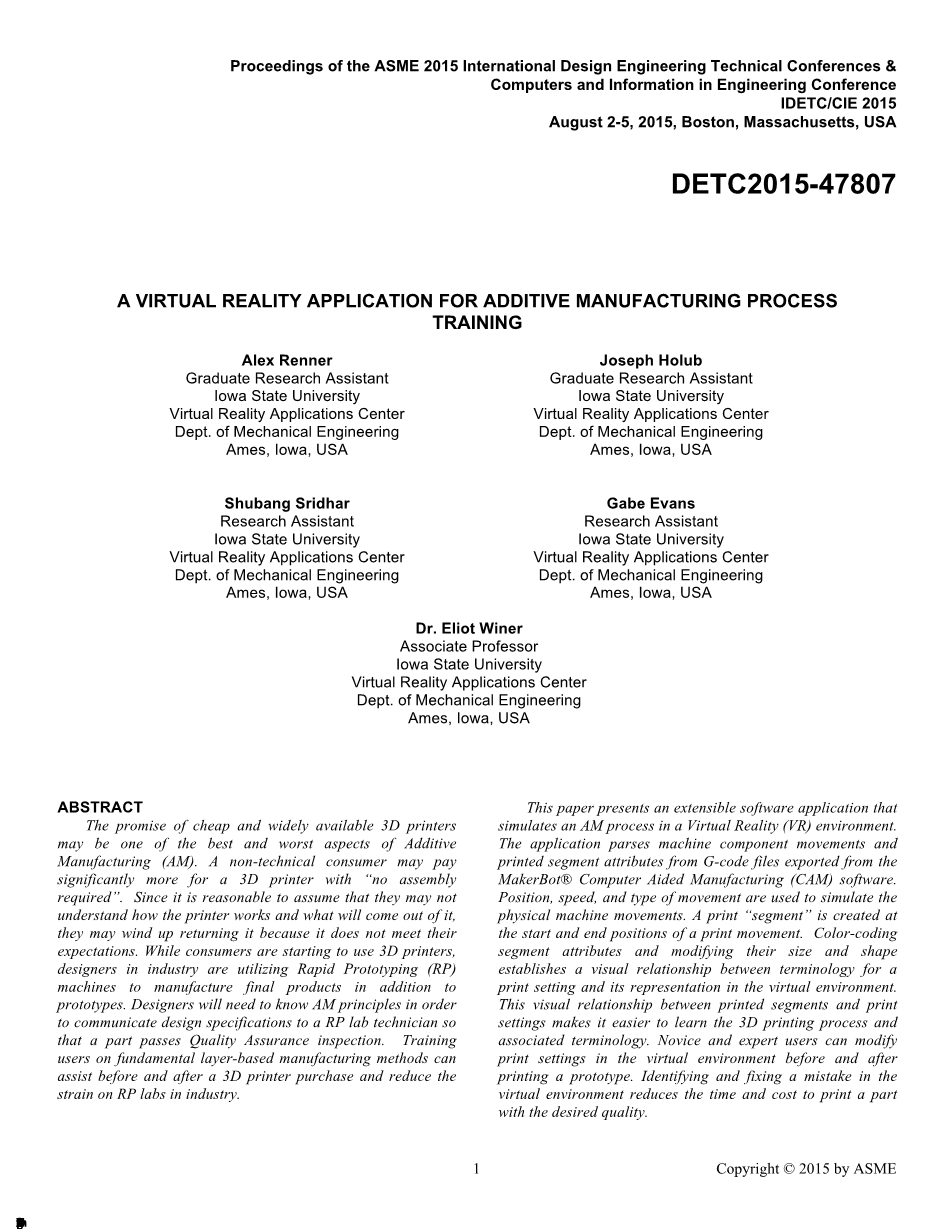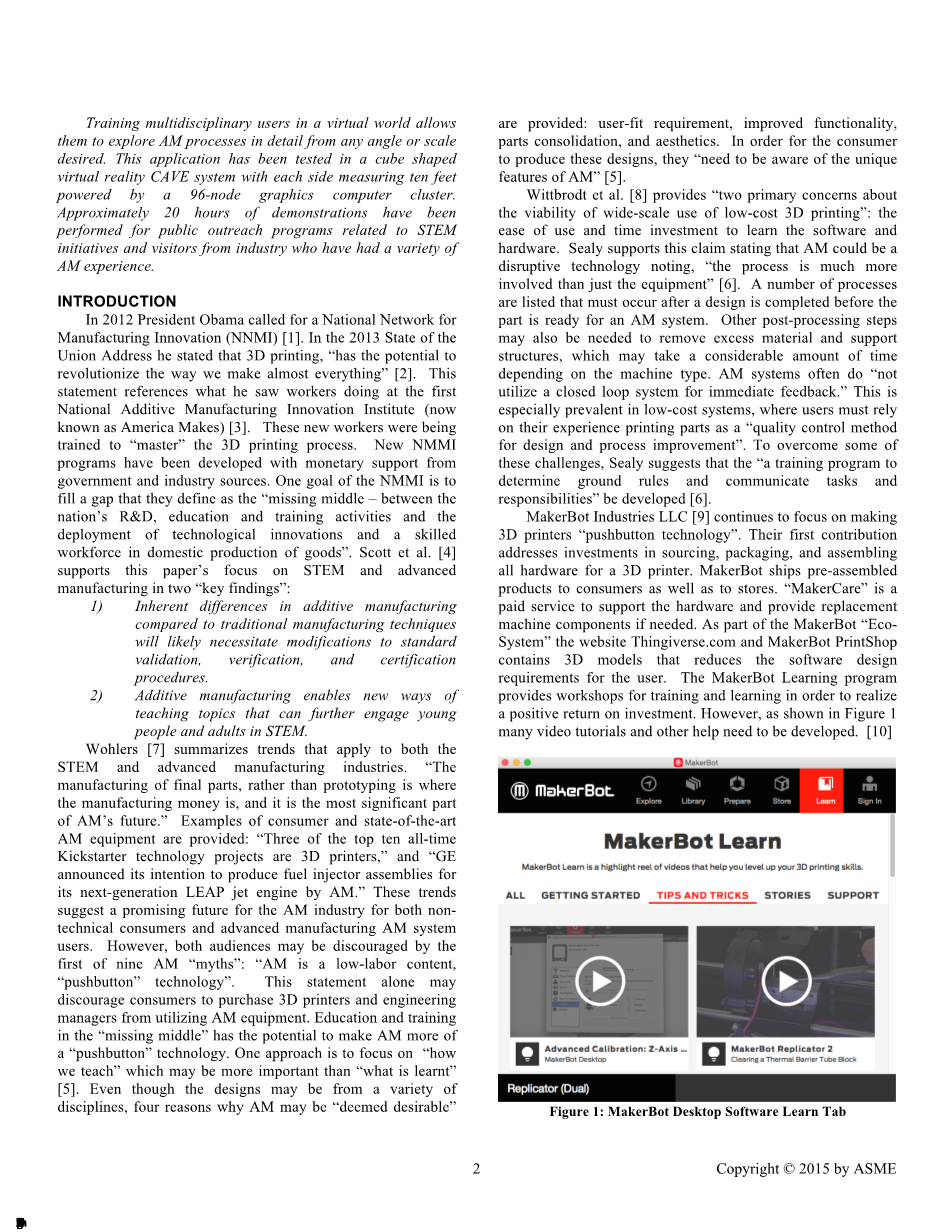增材制造工艺培训的虚拟现实应用外文翻译资料
2023-01-31 11:30:56


英语原文共 10 页,剩余内容已隐藏,支付完成后下载完整资料
原文
Proceedings of the ASME 2015 International Design Engineering Technical Conferences amp;
Computers and Information in Engineering Conference
IDETC/CIE 2015
August 2-5, 2015, Boston, Massachusetts, USA
DETC2015-47807
A VIRTUAL REALITY APPLICATION FOR ADDITIVE MANUFACTURING PROCESS TRAINING
Alex Renner
Graduate Research Assistant Iowa State University
Virtual Reality Applications Center Dept. of Mechanical Engineering Ames, Iowa, USA
Joseph Holub
Graduate Research Assistant Iowa State University
Virtual Reality Applications Center Dept. of Mechanical Engineering Ames, Iowa, USA
Shubang Sridhar Research Assistant Iowa State University
Virtual Reality Applications Center Dept. of Mechanical Engineering Ames, Iowa, USA
Gabe Evans
Research Assistant Iowa State University
Virtual Reality Applications Center Dept. of Mechanical Engineering Ames, Iowa, USA
Dr. Eliot Winer Associate Professor Iowa State University
Virtual Reality Applications Center Dept. of Mechanical Engineering Ames, Iowa, USA
ABSTRACT
The promise of cheap and widely available 3D printers may be one of the best and worst aspects of Additive Manufacturing (AM). A non-technical consumer may pay significantly more for a 3D printer with “no assembly required”. Since it is reasonable to assume that they may not understand how the printer works and what will come out of it, they may wind up returning it because it does not meet their expectations. While consumers are starting to use 3D printers, designers in industry are utilizing Rapid Prototyping (RP) machines to manufacture final products in addition to prototypes. Designers will need to know AM principles in order to communicate design specifications to a RP lab technician so that a part passes Quality Assurance inspection. Training users on fundamental layer-based manufacturing methods can assist before and after a 3D printer purchase and reduce the strain on RP labs in industry.
This paper presents an extensible software application that simulates an AM process in a Virtual Reality (VR) environment. The application parses machine component movements and printed segment attributes from G-code files exported from the MakerBotreg; Computer Aided Manufacturing (CAM) software. Position, speed, and type of movement are used to simulate the physical machine movements. A print “segment” is created at the start and end positions of a print movement. Color-coding segment attributes and modifying their size and shape establishes a visual relationship between terminology for a print setting and its representation in the virtual environment. This visual relationship between printed segments and print settings makes it easier to learn the 3D printing process and associated terminology. Novice and expert users can modify print settings in the virtual environment before and after printing a prototype. Identifying and fixing a mistake in the virtual environment reduces the time and cost to print a part with the desired quality.
Training multidisciplinary users in a virtual world allows them to explore AM processes in detail from any angle or scale desired. This application has been tested in a cube shaped virtual reality CAVE system with each side measuring ten feet powered by a 96-node graphics computer cluster. Approximately 20 hours of demonstrations have been performed for public outreach programs related to STEM initiatives and visitors from industry who have had a variety of AM experience.
INTRODUCTION
In 2012 President Obama called for a National Network for Manufacturing Innovation (NNMI) [1]. In the 2013 State of the Union Address he stated that 3D printing, “has the potential to revolutionize the way we make almost everything” [2]. This statement references what he saw workers doing at the first National Additive Manufacturing Innovation Institute (now known as America Makes) [3]. These new workers were being trained to “master” the 3D printing process. New NMMI programs have been developed with monetary support from government and industry sources. One goal of the NMMI is to fill a gap that they define as the “missing middle – between the nationrsquo;s Ramp;D, education and training activities and the deployment of technological innovations and a skilled workforce in domestic production of goods”. Scott et al. [4] supports this paperrsquo;s focus on STEM and advanced manufacturing in two “key findings”:
- Inherent differences in additive manufacturing compared to traditional manufacturing techniques will likely necessitate modifications to standard validation, verification, and certification procedures.
- Additive manufacturing enables new ways of teaching topics that can further engage young people and adults in STEM.
Wohlers [7] summarizes trends that apply to both the STEM and advanced manufacturing industries. “The manufacturing of final parts, rather than prototyping is where the manufacturing money is, and it is the most significant part of AMrsquo;s future.” Examples of consumer and state-of-the-art AM equipment are provided: “Three of the top ten all-time Kickstarter technology projects are 3D printers,” and “GE announced its intention to produce fuel injector assemblies for its next-generation LEAP jet engine by AM.” These trends suggest a promising future for the AM industry for both non- technical consumers and advanced manufacturing AM system users. However, both audiences may be discouraged by the first of nine AM “myths”: “AM is a low-labor content, “pushbutton” technology”. This statement alone may
剩余内容已隐藏,支付完成后下载完整资料
资料编号:[149929],资料为PDF文档或Word文档,PDF文档可免费转换为Word




